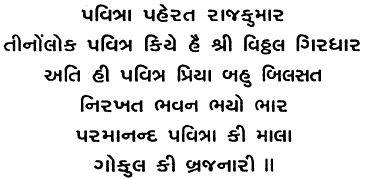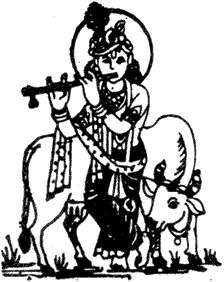
Purna Purushottam Prabhu Shri Krishna is an ocean of 16 divine qualities. His
lilas span the 6 seasons. 16 multiplied by 6 is 96. If this is multiplied by 3,
representing the three types of devotees, rajas, tamas and satvik, it reaches
the sum of 288. Adding to that, the 12 months, one reaches 300. By adding the 60
minutes of an hour a total of 360 is obtained and therefore a 360 thread cotton
pavitra is offered to Prabhu.
One year has 360 days. After taking Brahm Sambandh each vaishnav should perform
seva daily offering new clothes and food preparations to Thakurji. However,
human beings have limited capacity and are unable to fulfill this in totality.
Therefore, by offering a 360 thread pavitra, the clothing seva of an entire year
is represented. Prabhu is compassionate and bestows His grace by accepting this
as a full year's seva.
WHY IS A COTTON PAVITRA CALLED 'PAVITRA'
(SACRED)
That which is most beloved to us, the most pure and sacred, should be offered to
Prabhu. Cotton is considered to be the most beautiful, pure and sacred and
therefore is utilized in all vedic rituals. Of all things, cotton is the most
quickly consumed by fire and for these reasons is considered to be sacred. Shri
Hariraiji wrote a treatise entitled 'PAVITRAMANDAN'. In a 360 thread cotton
pavitra 180 knots are tied just as there are 108 knots in a mankamala (Japmala)
through which, Bhagavad bhajan and bhava is perfected.
In a couplet from the scriptures:

These words express that in Satyuga,
life spans one lakh years, in Tretayuga ten thousand years, Dwaparyuga one
thousand years and in Kaliyuga life span is not subject to any rules. One can be
freed of one destined span and obtain pleasure even in a moment, by the
repetition of Bhagvad name one hundred times is sufficient to absolve one of
their faults.
According to Shri Mahaprabhuji's instructions, four kinds of pavitras are
prepared and offered, each with
its own individual bhava. Kesri, Champa, yellow-satvik, predominant Swaminiji,
Radhaji's bhava red, pink-rajas, Chandrvaliji's bhava green-tamas, Radha
sahacheri, kumarika's bhava blue, purple-nirguna, Yamunaji's bhava
The great Ashtasakha poet and Bhagvad bhakta Paramananddasji describes pavitra:

In ancient literature, there is decription of the different bhavas of pavitra.
Kesri coloured pavitra represents satvik bhava, white and red represents rajas
bhava, green coloured is tamas bhava and sky blue is nirguna bhava. A five
coloured pavitra represents the bhava of all the Brij Bhaktas. The tradition of
pavitra has come down from ancient times. In Satyuga, the pavitra was jewel
embedded, in Tretayuga it was golden, in Dwaparyuga it was silk and in Kaliyuga
cotton is offered. On pavitra Ekadisi, Prabhu accepts the pavitra of all the
different types of devotees, bestowing them accordingly, with the appropriate
type of Bhakti Bhava. On this day pavitra is placed every where in seva, on the
pichhwai, singhasan, khand pat, palna and hindola. The under lying Bhava is that
Brij Bhaktas are having Prabhu's darshan from all the ten directions. Pavitra is
offered during the month of Shravan in which there is no bhadra (i.e.
inauspicious time).
After offering pavitra, misri is offered to Thakurji. Of all things misri is the
most sweet and nectar-filled. Misri is offer to Prabhu with the Bhava of
Swaminiji's sweet divine nectar. Instructions for offering misri in seva is
therefore given to every vaishnav.
On Pavitra Ekadisi, Shri Nathji is adorned in Kesari bordered white cloth in the
sacred thread ceremony or in marriage white cloth with the auspicious haldi
coloured yellow border is used. For that reason white cloth is utilized in
Prabhu's meeting with Shri Vallabh. Kesri colored kuley is offered indicating an
auspicious celebration and dhadhi is sung.
![]()
On each of the five days from ekadisi to full moon, pavitra is offered through
which the five essential elements and the five types of faults are purified.
![]()
If for any reason one is unable to offer pavitra during these five days, it may
be offered in the palna on Nandmahotsav for removing the five types of faults.
In the treatise entitled 'Utsav Vritant' Shri Purushottamji, states that each
vaishnav should definitely offer pavitra with devotion on Pavitra Ekadashi
because otherwise the entire year of seva will be fruitless.
'Pavitra baras' is the day of ultimate fulfillment for each vaishnav. On that
day Shri Mahaprabhuji gave the first Brahm Sambandh to Damodardas Harsaniji, his
foremost sevak. On this day all the descendent Goswamis offe? pavitras and misri
to each other after which vaishnavs offer pavitra and misri to their Gurudev.
While offering pavitra, each vaishnav should hold the bhava that his Gurudev is
Shri Mahaprabhuji and should regard himself with the bhava of Damodardas
Harsaniji.

Pushti Marg embodies perfect knowledge
and is replete with compassion. I offer my obeisance to Gurudev who bestows the
ultimate fruit. This bhava should be kept for Gurudev, most worthy of worship,
at the time when pavitra is offered.
Each vaishnav should have constant remembrance that how much strain Shri
Mahaprabhuji underwent and accepted of his own will, for the sake of giving
Brahmsambandh to daivi souls unifying them in relation with Brahm. This was an
undertaking of supreme significance. Remembering this, vaishnavs should
surrender every thing to Prabhu and perform seva with total love and bhava.
Pushti souls do not have a body for their own happiness but for Prabhu's
pleasure only. It can be considered that the celebration of the twelfth day of
shravan has reached ultimate fulfillment when vaishanvs dedicate themselves
totally in physical seva performed with their own wealth leading gradually to
the pinnacle of mansi seva.
Before offering pavitra, the heart should be purified, sanctified and all faults should be removed. One should be totally absorbed in seva, satsang and remembrance and all worldly attachment should be offered to Prabhu. Through this alone the five types of ignorance can be removed. On the day of Pavitra Baras at the moment of offering pavitra, a bhava of surrender should be kept and a unwavering resolve to live a life in accordance with Pushti Marg principles. Then only it can be considered that the inception of Pushti Marg has realized its ultimate aim. The day of Pavitra Baras is like Guru Purnima for Shri Mahaprabhuji's Pushti Marg and should be celebrated with this bhava deeply imbibed.

|
This E-Book is Brought to you by Pushtikul Satsang Mandal Email : - anand@pushtikul.com |